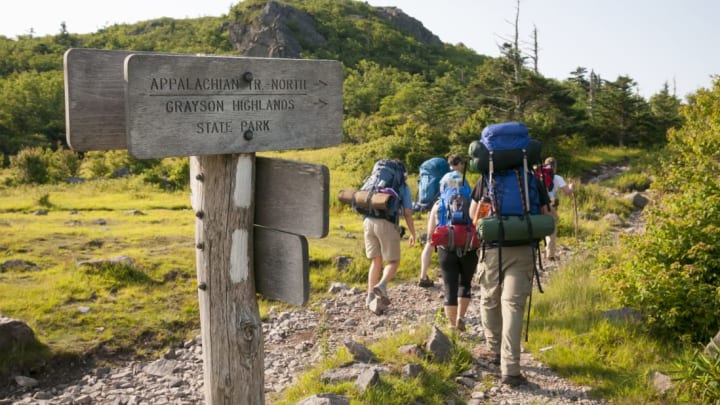You can find a hiking trail or walking path almost anywhere in the United States, whether you're deep in the backcountry or a few yards from a parking lot. Most casual hikers probably give them little thought before lacing up their boots, but hiking trails don't just appear naturally. Sure, the popular pathways are created with shovels and sweat and grit, but that's not all: Modern trail construction actually involves a significant amount of anticipating what potential hikers will do and analyzing the area surrounding the route. The ultimate goal: "A useful trail must be easy to find, easy to travel, and convenient to use," according to the USDA Forest Service’s Trail Construction and Maintenance Notebook [PDF].
Before the first ground is even close to being broken, trail designers consider the trail-to-be's location and its potential users. Will visitors be hardcore hikers looking for a new challenge? Or is the trail to be set near an urban area, where hikers are considered more casual? Will more than just hikers need to use it? All of these factors will determine a trail's layout and design.
To figure out the right layout, trail designers consult protocols like the Forest Service Trails Accessibility Guidelines [PDF], which detail “Trail Management Objectives”—the intended users, desired difficulty level, and desired experience—that will determine the width, as well as the type of tread, of the trail. If the hikers are experienced, a narrow, single track path can probably handle that population. But more casual hikers—think friends out for a picnic, families, or dog walkers—are more likely to walk and talk side-by-side. If the trail is designated as multi-use—meaning it's open to multiple user groups, like bikers, equestrians, cross country skiing, etc.—that’s also central to planning.
Next comes the direction of the trail, which is determined in part by psychology. Studies have shown that humans naturally follow the path of least resistance. If a muddy puddle collects in the center of a trail, for example, a majority of hikers will maneuver around, rather than trudge through, the mud, without putting much thought into their decision. One person skirting the puddle doesn’t make much difference, but a steady stream of well-meaning outdoor enthusiasts will quickly expand the original trail. People might begin to form separate “social trails” created by rogue hikers simply stepping on previously undisturbed land. As trail designer Erik Mickelson shared with The Wall Street Journal, "You’ll lay it out, you think you’ve done it well, and then they make a shortcut and you’re like, ‘Damn, why didn’t I see that?’”
The result of these hikers' minor adjustments is the destruction of more habitat. So trail designers must consider natural obstacles like potential puddle spots, loose rocks, steep inclines, and water crossings before laying out a route. Often, they'll consult topographic maps, compasses, surveyors' instruments, and aerial photos to make the first broad strokes. The macro view allows designers to establish positive control points, like a lake or waterfall, and negative control points like a field of poison ivy.
If avoiding the problem completely isn't possible, builders work to minimize the impact on the environment. One common trick used to subtly contain the creation of social trails is the installation of “gargoyles.” [PDF] Often stone or a large rock (thus the name), but always made of natural materials, gargoyles divert hikers away from potential short cuts by creating an obstacle harder to cross than the path itself. For example, a collection of fallen trees and vines might be piled around the entrance of an old social trail to block the way. A few well placed rocks could also create a seemingly natural endpoint to a one way trail. If you hike, you’ve likely come across a gargoyle without noticing it.
Ultimately, hiking trails are destructive to the environments they provide access to. They tear through the land, disturbing the natural layout and leaving it much more vulnerable to erosion. The people who design and build trails put a lot of thought into constructing the most sustainable path possible. "There is a real art to trail layout," the authors of the USDA Forest Service’s Trail Construction and Maintenance Notebook write. "Some basics can be taught, but the person locating the trail must develop an eye for laying a trail out on the ground."
So next time you’re out for a hike, make sure to stick to the trail—there's more to it than you might think.
